The Crossing
You get a little crazy on an ocean crossing. Whether it’s the constant motion, the monotony, sleep deprivation, close quarters, the raw power of the ocean, or something else I’m not sure. But by the end of the voyage, a brand of giddiness sets in that infects most everyone.
This voyage started with craziness.
Emily safely home, a new strong crew showed up in Ketchikan – John Hoopes and John Renna. My given name is also John. (Most Jacks are actually Johns don’t you know.) So we had a crew of Johns on this voyage.
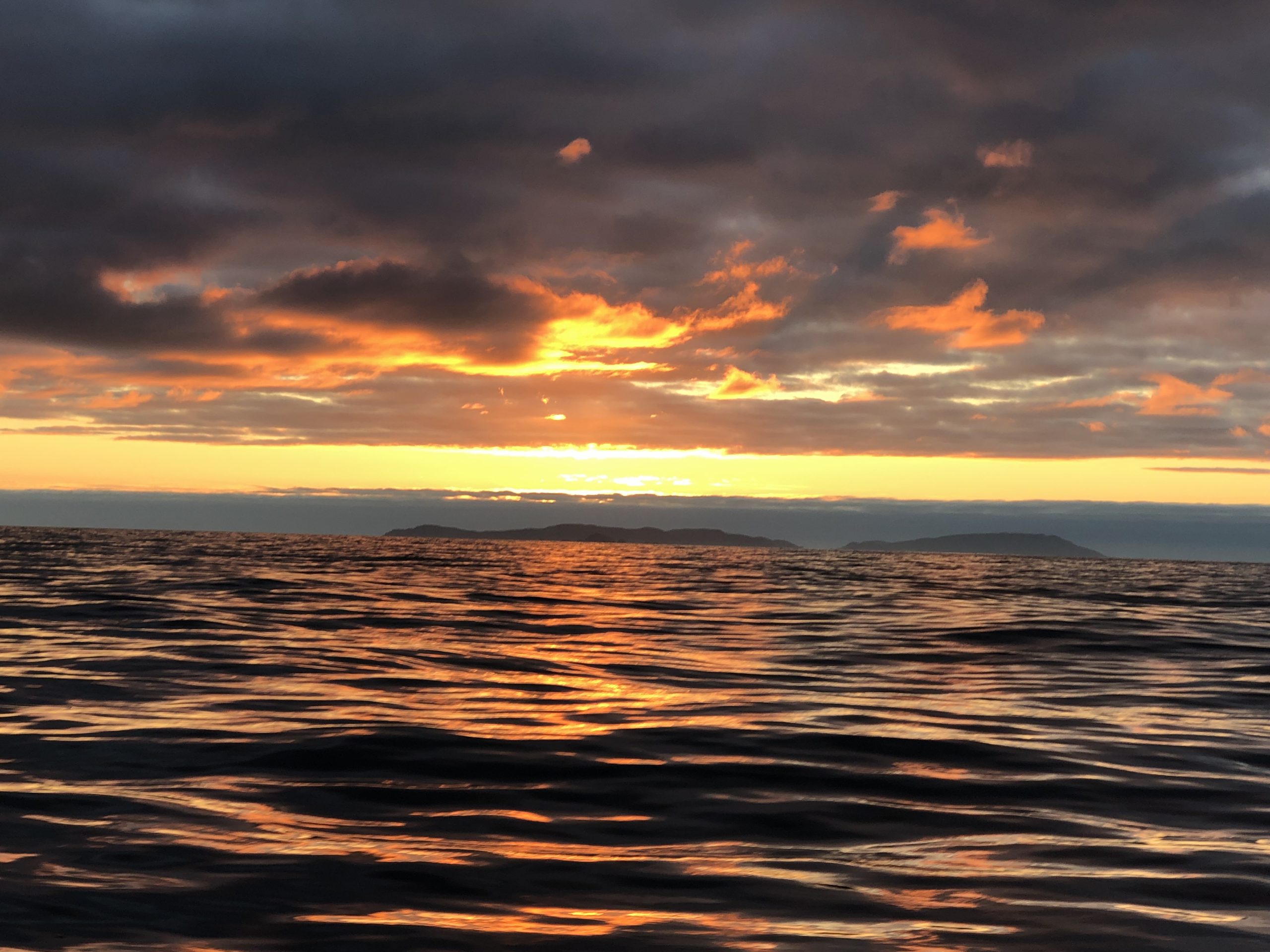
We needed crazy voyage names to make things easier. John Renna would now be known as John Reno, or Reno for short. John Hoopes would become Johnny Donut, an internet alias he has occasionally used as a riff on John Doe. I would go by Cap, short for captain. (Not that cray cray, I know, but what can I say?)
As usual, the wind made the decision easy on when to go. A five-day weather window would open starting the day after the new crew’s arrival, just long enough for the 600-nautical-mile passage to Port Townsend, Washington. After a day or so of light wind, moderate to strong breezes would line up behind the beam the rest of the way. Perfect! Then the window would slam shut with southerlies and snotty weather returning to Southeast Alaska and the BC coast.
We had to jump through that window.
We toyed with the alternative of floating around the Southeast for a week waiting for Canada to open up. Ottawa had just announced new rules allowing U.S. travelers to enter Canada starting August 9th provided they were fully vaccinated and recently tested COVID negative. But the Council of the Haida Nation had not yet followed suit, keeping Haida Gwaii, the most appealing stop on the way south, out of bounds. Plus, waiting a week would require a new weather window to open, which did not look likely. We resolved to go now, leaving Haida Gwaii for another season.
But first, we had 24-hours to bond. It started with a delicious baked pasta dish washed down with red wine on the evening of the crew’s arrival. It continued the next day with a forest hike above town, a rejuvenating pint at the Bawden Street brewery, a touristy walk down Creek Street, and a satisfying meal at the New York Café, all before returning to the boat by 4 pm.
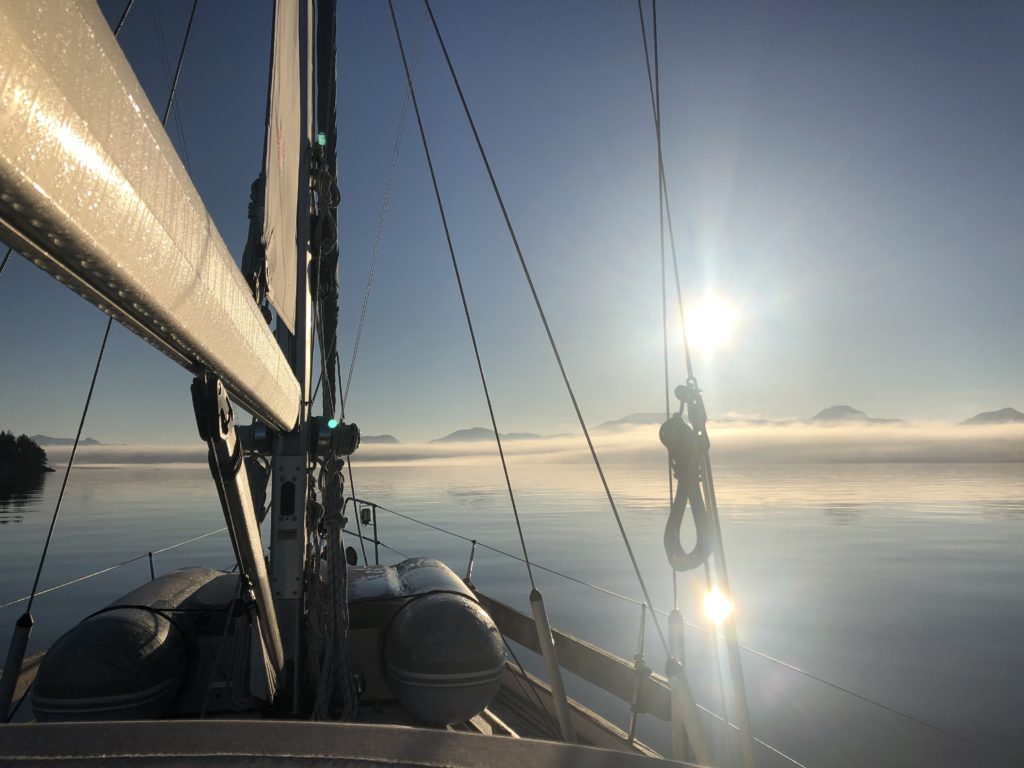
Before shoving off, I assigned tasks to the crew to help them get oriented. They performed a rig check, inspected and familiarized themselves with their PFDs, and identified the location of all the fire extinguishers and bilge pumps on board. We then met in the cockpit to talk about what they found and review the weather forecast and passage plan. I emphasized three personal responsibilities to promote a successful crossing – nutrition, hydration, and prostration; if each of us made sure to keep ourselves nourished, hydrated, and well-rested, the chances of our success would go up. After then talking about the sequence for casting off, we left the dock close to 5 pm.
Rather than blast off right away, I thought it best to give the crew a night swinging at anchor. Thirteen nautical miles south of Ketchikan, we entered Dall Bay and proceeded to a quiet cove at the head of the bay. A whale greeted us as she fed at the cove’s mouth and bald eagles circled overhead, a fitting finale for our time in Alaska. Windleblo swung serenely at anchor through the night, rock solid as we slumbered.
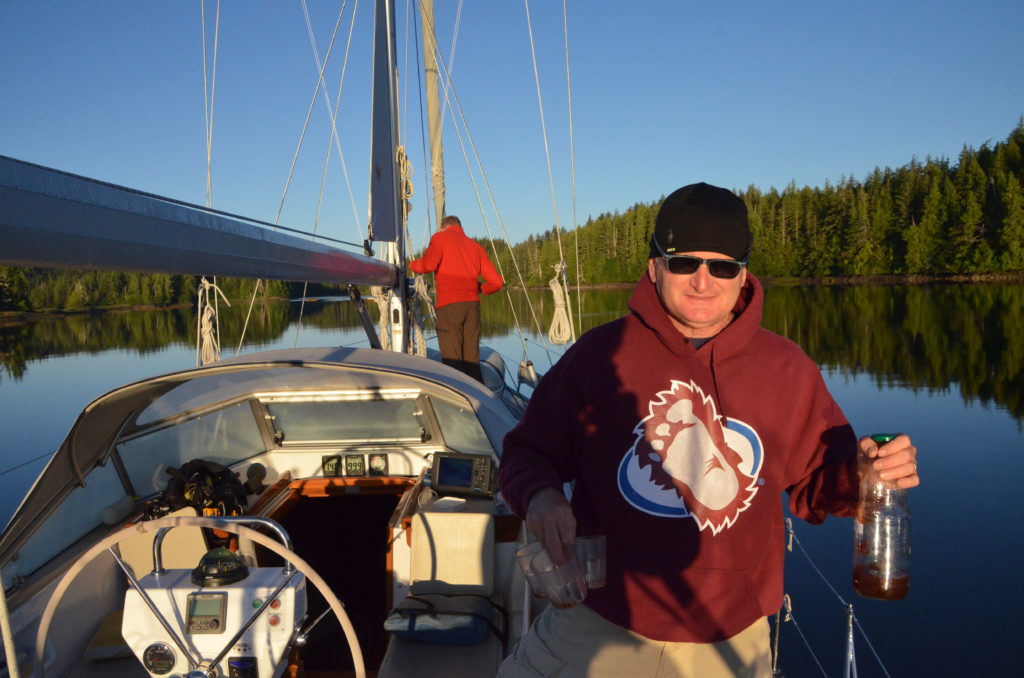
Before weighing anchor the next morning, we gathered on the foredeck at 0600 to petition Neptune for a safe crossing. Reno led the recitations, entreating the seven directions on our behalf. A dram of Croatian brandy went to Neptune, along with a dram each down our gullets.
Ceremony complete, our voyage started in earnest. As predicted, light winds prevailed at first, some on the nose but less than 10 knots, not enough to bother. We soon escaped the confines of the Anderson Archipelago, open ocean to starboard, happy to ride a smooth sea with half meter swell. As the mountains on Prince of Wales Island receded, the winds picked up and shifted west giving us a glorious beam reach across the Dixon Entrance. Only the occasional deadhead log made our way a bit tricky. As day turned into night, we watched Rose Point at the northeast corner of Haida Gwaii slide past our starboard beam, frustrated that COVID restrictions meant we could not make landfall on these alluring islands. We entered Hecate Strait.
Often, crossing Hecate Strait at night is a hair-raising experience. Johnny Donut read in one of our Haida Gwaii reference books that “Hecate Strait is reputed to be one of the roughest stretches of water on the Pacific Ocean,” largely because it is relatively shallow and wind over tide conditions can create huge short steep waves. Our weather window did not betray us, though, and we motored on flat seas under cloudy skies. Solo two-hour watches kept us on track through our first night at sea. By dawn we had well surpassed our first hundred nautical miles, grateful for not having collided during the night with any of the many logs we saw floating in the strait during daylight, sometimes entire trees, roots and all.
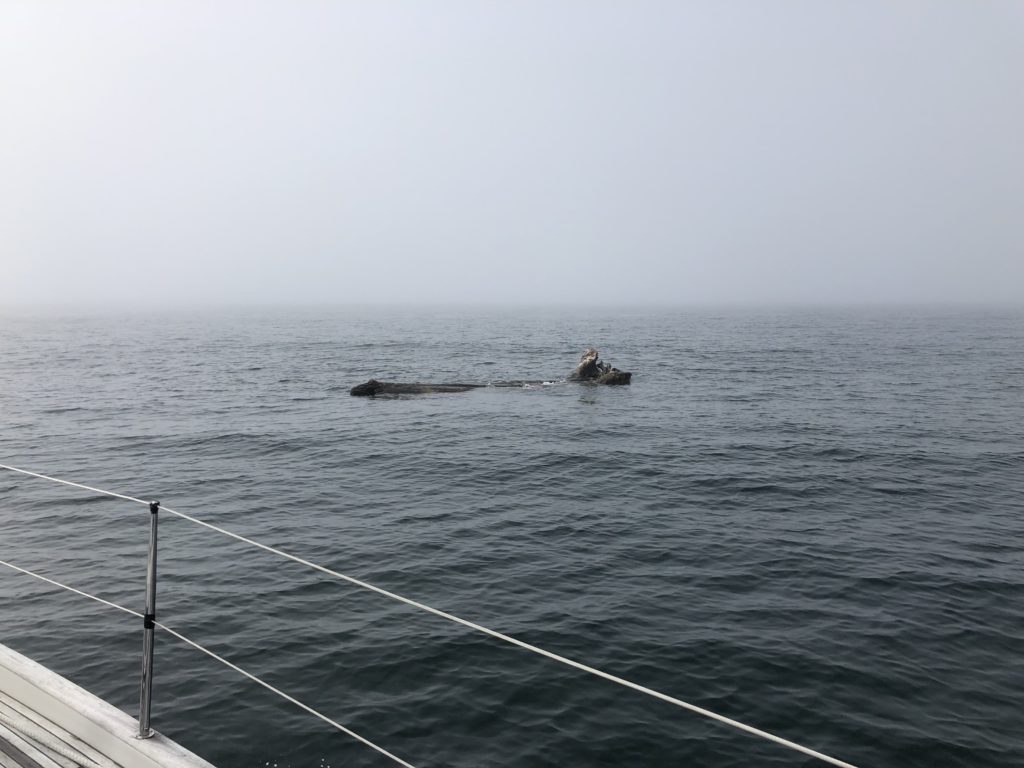
Early on Day Two, August 1, 2021, I noticed an error code on the Mastervolt battery monitor indicating that the batteries were overheating. As a precaution, the monitor had automatically interrupted charging. Immediately, I switched off the engine and investigated. Thankfully the wind was starting to fill in behind us and we continued to make decent way under sail. Exposing the battery box confirmed the error code. The batteries were indeed very hot to the touch. I increased ventilation to the box and vowed to keep the engine switched off as much as possible the rest of the way, operating only enough to maintain charge once the batteries cooled. I already knew the batteries were on their last legs; this added greater impetus to replace them ASAP.
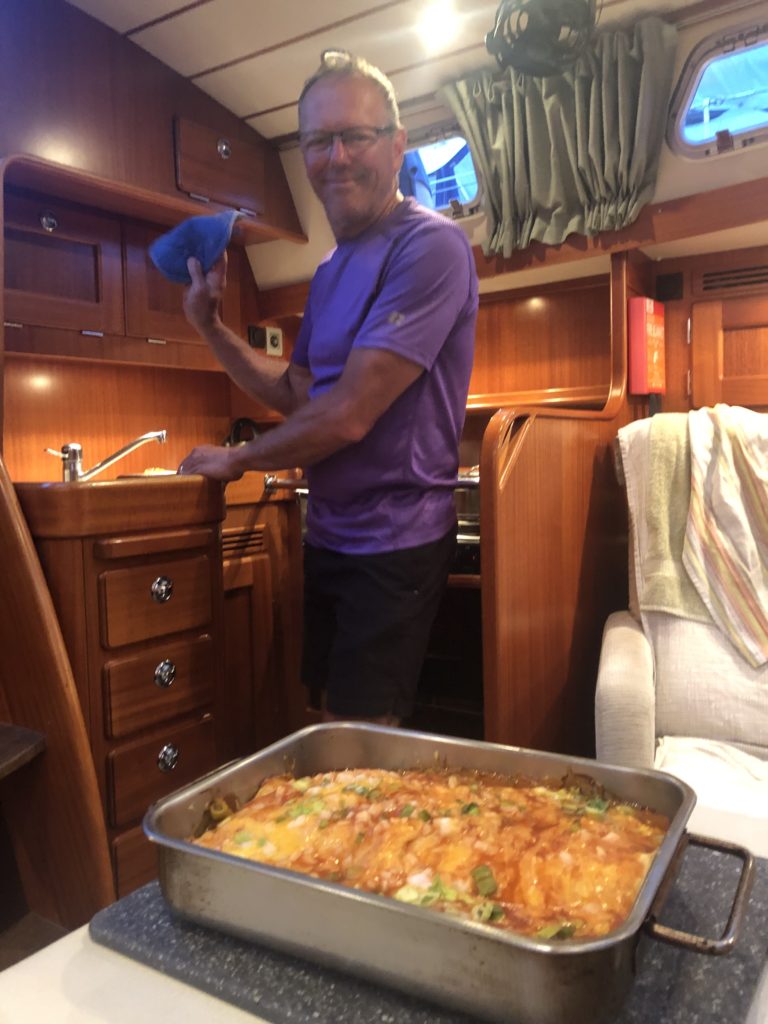
It was easy to tell when we left Hecate Strait. Deep blue water and steady one meter swell on our starboard quarter told us we were entering open ocean. A cloudless sky completed the blue panorama. Fifty nautical miles offshore now, we were as far from land as this crossing would take us. A consistent ten to twelve knots of wind slightly behind the starboard beam allowed us to break out the gennaker and bust along at seven knots through the water. Life was very good indeed. Fish chowder for dinner took top honors as the best meal of the passage. At midnight, the milky way was stunningly vivid, punctuated occasionally by shooting stars. A waxing gibbous moon rose as a crescent shining over the wee-est hours before dawn.
By Day Three, we were well into the rhythms of a sea crossing. The motion of the boat seemed pleasing, symptoms of sleep deprivation crept in, and the routines of running the boat kept us occupied. Foremost among these was adjusting the sails to suit the conditions. As the wind freshened and backed behind us, we exercised our deck skills setting up the whisker pole to run wing-on-wing. Off the top of Vancouver Island, the wind died. Headsail furled and boom pinned to the centerline, we switched on the motor. Listening to the VHF weather, a gale warning was posted for later in the day and into the night. A satphone call to Jocelyn confirmed the forecast. Twenty-five to thirty-five knot winds from the northwest were forecast through the night.
The dead air we were now motoring through appeared to be the calm before the storm.
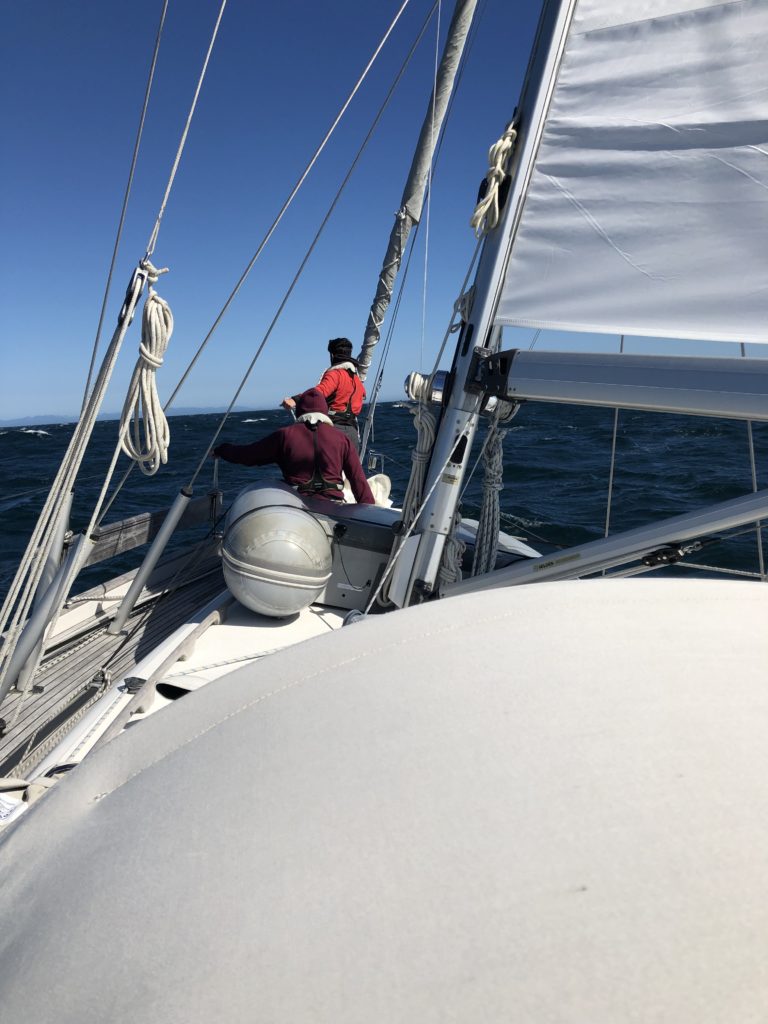
By mid-afternoon, the promised winds began to build. I thought about shrinking the sails down as the winds rose, but then decided to break out the staysail from deep in the hold. It had not seen daylight for several seasons and needed airing out. As the sun set, we secured the removable stay to the strong point in the middle of the foredeck, furled the genoa, reefed the main, and hanked on the staysail. Tidying up below secured anything loose. We were ready for the gale.
Two-meter breaking waves on our starboard quarter shoved the transom around. The winds rose steadily as night fell and brilliant stars emerged. We rotated through our watchkeeping schedule. By morning, it was clear we had dodged a bullet. The highest observed gust was only in the high twenties, the seas moderate. As daylight took hold, we put away the staysail, raised the whisker pole, and went back to wing-on-wing. Gawking at the glory of the Vancouver Island mountain landscape to port, we cursed COVID for frustrating our intentions to explore this coast.
As we approached the Straits of Juan de Fuca, it seemed most of our work was complete. Five hundred nautical miles had been logged. Protected waters spread before us. But fully twenty percent of the voyage remained. To remind us that we were not yet done, the winds again died and a foggy drizzle enveloped us. We soldiered on through the cold damp, hugging the Canadian side of the strait to avoid foul currents and stay out of the shipping lanes.
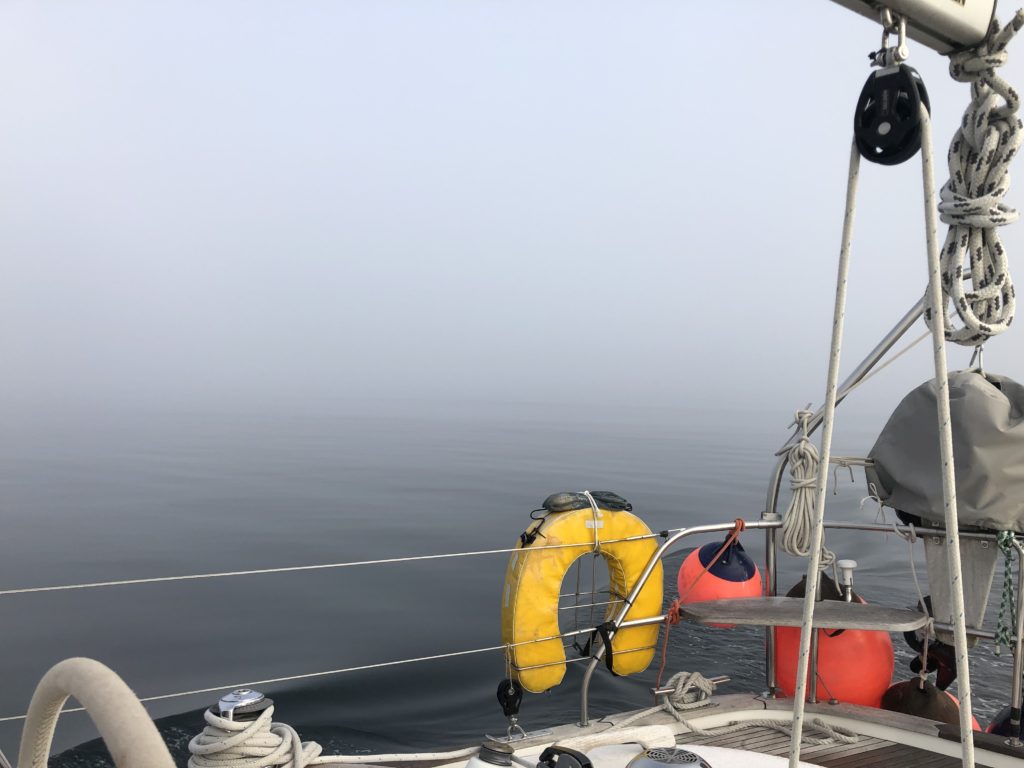
Our fourth night at sea began shrouded in fog. Initially motoring, the wind returned, again right behind us. We had kept the whisker pole up, so it was a simple matter of unfurling the genoa to resume sailing. At the 1 am watch change, we furled the headsail, jibed the boat, and turned ninety degrees to starboard to cross the Traffic Separation Scheme at a right angle. Once across, we turned downwind and resumed our easterly heading, now under full sail with a fresh breeze. As day broke, fog returned. Port Townsend lay just ahead.
Rounding Point Wilson, we entered Port Townsend as the fog burned off. Hailing the port authorities, we were assigned slip C178 in the Boat Haven. Bright blue sky greeted us as we glided into the slip, our voyage complete.
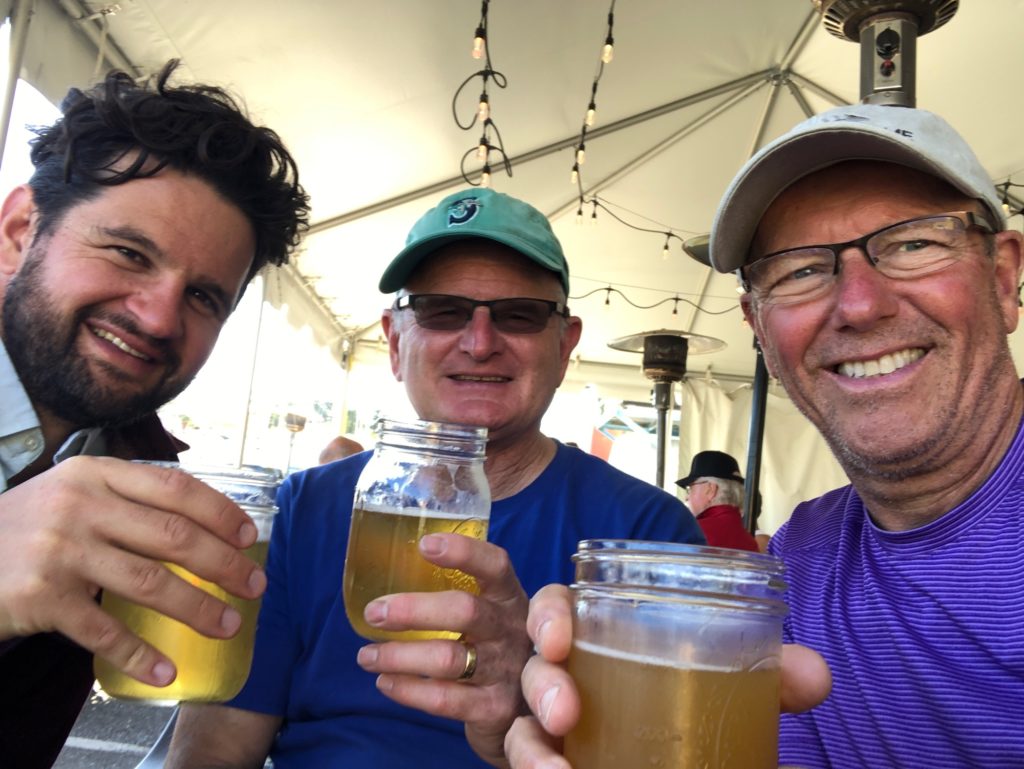
A jubilating giddiness enveloped the crew as we relished our accomplishment. Five days at sea and the boat had been moved from its Alaskan adventure ground to its new home waters. We could now relax, knowing our goal was reached. Next was food, beers, hot showers, and sleep.
Over beers, I asked the Johns to give me five words each that captured their sense of the voyage. Here is what they said. Reno: Epic, Challenging, Teamwork, Ordered Disruption, Awe Inspiring. Johnny Donut: Delightfully Uneventful, Too Short, Trance-like/Entrancing, Nostalgic, Humbling/Whales.
Not too crazy, but a fitting summation of a smooth crossing.

Comments
The Crossing — No Comments
HTML tags allowed in your comment: <a href="" title=""> <abbr title=""> <acronym title=""> <b> <blockquote cite=""> <cite> <code> <del datetime=""> <em> <i> <q cite=""> <s> <strike> <strong>